
AFRICAMUSE IN PERU
In 1995, while working in a South African museum, I was given the formidable task of presenting a paper on Ancient Peruvian Ceramics to a workshop of the National Potters Association. I was horrified! I knew nothing about Peru and less than that about ceramics! I had a few months to read and examine our very small collection of Peruvian artifacts, and in that time developed a strong feeling for this part of our collection. I am happy to say that I gave an excellent 'performance' at the workshop, and went on to take care of and write about the collection.
I had always wanted to visit Latin America, but it was at this time that my desire to visit Peru crystallised.
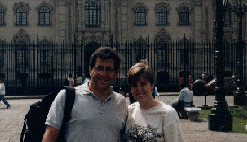
On the last weekend of June 1999, Roberto and I took a 'sandwich day' and a four day trip to Peru. There are so many things we would have loved to see in Peru, not least being Cuzco, Machu Picchu and Lake Titicaca, but we only had four days, and decided to spend them in and around Lima. So many people I'd spoken to (and travelogues I'd read) told me what an ugly, dirty, horrible city Lima was, and my expectations of the city itself were consequently very low. But I was pleasantly surprised when we got there. Sure, it is far from the most beautiful city in the world, but there are incredible museums, beautiful (if sometimes dilapidated) architecture, pleasant areas, and exceptionally friendly people.
We stayed at El Pardo, an excellent hotel in the Miraflores area, one of the nicest suburbs in Lima. I cannot overstate how impressed we were with the service and hospitality we received there.
We spent most of our time in Lima at museums, and the next seven paragraphs or so deal exclusively with Lima's museums. If you are not interested in museums, maybe you want to skip these and go on to read about Pachacamac and Nazca. There are some incredible things to see! There are many, many museums in Lima, but the two with which I was most impressed were the National Museum of Archaeology, Anthropology and History of Peru (Museo Nacional de Arqueologia, Antropologia e Historia del Peru) and the Gold Museum (Museo de Oro).
The National Museum of Archaeology, Anthropology and History of Peru is amazing. I learned more from a couple of hours in the museum than I had in all the books I'd read about pre-historic Peru. Take the guided tour - it is well worth the extra cost. There are a few English speaking guides available. We had a Spanish-speaking guide who obligingly spoke very slow, clear Spanish, scattered with as much English as he knew, and I enjoyed the tour thoroughly!
We unfortunately left the Gold Museum until last - a brief visit before we had to leave for the airport. This was bad planning on our part, and if we had known better we would have planned our stay so that we could have spent more time there. As well as containing a mind-boggling amount of gold artifacts, it has large numbers of other good pre-historical pieces. These include erotic ceramics (for which pre-historic Peru is justly famous), textiles, skulls lovingly covered with dyed feathers, and so much more. Upstairs from this exhibition is another dealing with weapons of the world - we had to wrench ourselves away without a second glance, else we would have missed our plane :(. Another disadvantage of leaving this museum for last is that we had a serious case of museum fatigue by the time we got to it, and didn't learn from it or enjoy it nearly as much as we would have earlier in the trip.
Other museums we visited included the Museo Arqueologico Rafael Larco Herrera, the museum of the San Franciscan monastery, and the museum of the Spanish Inquisition.
The Herrera museum is most well-known for its collection of erotic art, which is housed in a separate hall that was unlocked for us. In my opinion, this collection is overrated. Far better pieces can be seen in the Gold Museum (above). What I did find fascinating about the Herrera museum was its open storage exhibition. Shelves upon shelves upon shelves of artifacts, creating an overpowering impression in their sheer quantity. Comments I've heard about this museum indicate that many miss the point - this particular part of the museum is NOT intended to be an educational exhibit, showcasing individual, selected pieces to teach visitors about certain aspects of Peruvian culture. Instead, it is meant to give a 'backstage' view. As the curator of a rather different open storage exhibition in a museum in South Africa, I found it very interesting.
The San Franciscan monastery is an interesting visit, especially for those who are interested in religious paintings and other artworks dating from the Spanish colonial era onward. This is not my particular field of interest and, in comparison with the other museums I have written about, I found the tour rather monotonous. This could, of course, have been due to the museum fatigue we were experiencing. The most common reason for visiting the monastery is to see the thousands of human bones in the underground 'catacombs' (really a large crypt). I don't know what it is about human remains - I am quite confused about the ethics of displaying human remains in museums, and yet I, like everyone else, am fascinated by the mummy bundles, the deformed skulls, the burial grounds of Peru. Nevertheless, I was quite unpleasantly surprised at the way these bones were arranged by the archaeologists who had excavated the crypt - an example is the well-like structure filled with the concentric circles of skulls and femurs - visually very striking but ethically...? I don't know, but it made me very uncomfortable.
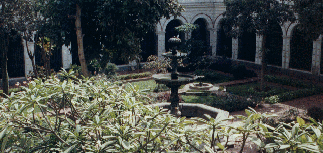
The museum of the Spanish Inquisition was also rather disappointing. Of course it was interesting to be in the site of the headquarters of the Spanish Inquisition in Latin America, but I was not overly impressed with the museum. We unfortunately latched on to a Spanish-speaking tour and I found our guide difficult to understand, but there were English-speaking tours available.
Phew! Enough about museums! They were great, but I am re-experiencing the museum fatigue just writing about them!
The best parts of our trip were outside Lima - our visits to Pachacamac and Nazca.
Pachacamac is a short drive south of Lima. This is an ancient, multi-cultural ceremonial center, which was utilised by various cultures spanning different eras. It was not a regular city, and only the priests, and others connected with the worship and rituals which took place in the centre, lived there. Others made regular pilgrimages to the ceremonial center and, consequently, a large variety of cultural artifacts are found there.
Huge, solid pyramids, dating from many thousands of years ago up until the Inca period, are crisscrossed by a number of paths, including the two main, low-walled highways. The walls served two purposes - they defined the roads, but also provided a surface on which the holy people could walk, above the common pilgrims.

Some of the pyramids are so old as to seem like huge, indistinct mounds of earth. Others look as if they were constructed yesterday. We climbed with our guide to the top of the Inca Pyramid of the Sun. It was incredible! We arrived to the top, hot and tired, and were confronted by a stunning view of the ocean and a fresh sea breeze. I had not realised how close we were to the coast - the temple stands on a high hill a few metres from the beach, believed by the early Peruvians to be the most westerly point in the world, and providing what I can only imagine must be a perfect view of the sunset.
The Incas must have thought so too - the western side of the pyramid's summit has two distinctive features, the mummy 'seats', which are open and face the sunset, and the sacrificial platform, where human and other sacrifices were performed. It seemed so incongruous, to be standing in such a pleasant place, and to think about the ground soaked in blood.
We then walked down to the place of the moon, the place where young girls selected on the basis of their intelligence and beauty were kept, cloistered from the community, and educated for their future role as virgin sacrifices - or, for a rare few, as wives of the Inca. One can walk through the communal bedrooms of the young girls, and wonder about what their thoughts and dreams and fears were.
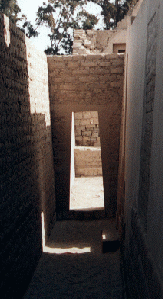
We spent a day travelling down to Ica. This was a long drive down the Peruvian coast, and it was very interesting to see how the Peruvian landscape develops. This part of Peru is largely desert, and one drives through barren brown sand, interspersed with towns located in green river valleys. From Ica, we took a 90 minute flight over the Nazca Lines. The Nazca Lines are large designs in the desert floor. There are literally thousands of them, some geometric and others in the form of birds, a monkey, hands, etc. They are impossible to make out from ground level, being many hundreds of metres in size, and it is somewhat of a mystery as to why they were created. Current theories seem to suggest that their creation and maintenance had something to do with the need for water and the gods of rain and fertility.
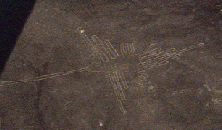
There's not much more to say about the Nazca Lines. I cannot do justice to them. the pictures give some idea of how great they are, although they don't do justice, either.
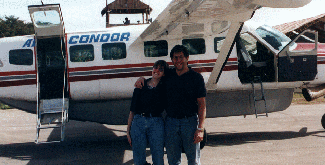
We left Peru regretting that we didn't have more time - and I have resolved to return one day to explore the interior of the country.
HIGH POINTS:
Pachacamac, especially climbing to the top of the Pyramid of the Sun.
Being spat at by an alpaca, in Ica.
Flying over the Nazca lines.
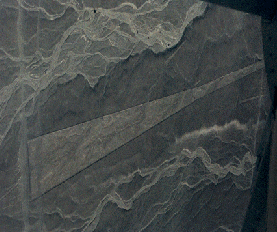
A gift from Roberto, a silver chain and pendant, in the shape of one of the Nazca images. Which one? The monito, of course :)...(You can see it in this background.)
The pillowfight and 'pillows on the heads' episode in the aeroplane on the way back to Chile.
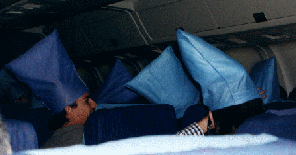
LOW POINTS:
A feeling of sadness throughout the trip - both of us knew that this was possibly the last time we would travel together.
Not making it to Chancay, the point of origin of the artifacts with which I used to work in a South African museum.
Laryngitis, a cold, and nausea, especially during the flight over Nazca.
Neither of the postcards I sent from Peru to South Africa, one from Ica and the other from Lima, arriving at their destination - especially sad as one of these would have been the last postcard my mother would have received from me before she died.
A REGRET, A DREAM...OR AN AMBITION?
Update: 26 May 2000
I very badly want to go back to Peru someday and walk the Inca Trail up to Machu Picchu. Maybe for my thirtieth birthday?UPDATE: To read about how I ALMOST realised this dream, read about my second trip to Peru here.
For an excellent site on the Inca Trail, enter here - it has answered many of my questions.
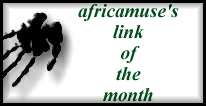
Useful Links:
Useful Books from Amazon.com:

|

|
Quick travel:
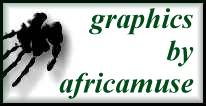

|

|

|
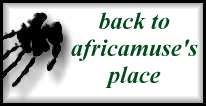
all original material (text, graphics, photographs and programming) © 1999-2006
Sally Smith
http://geocities.datacellar.net/africamuse